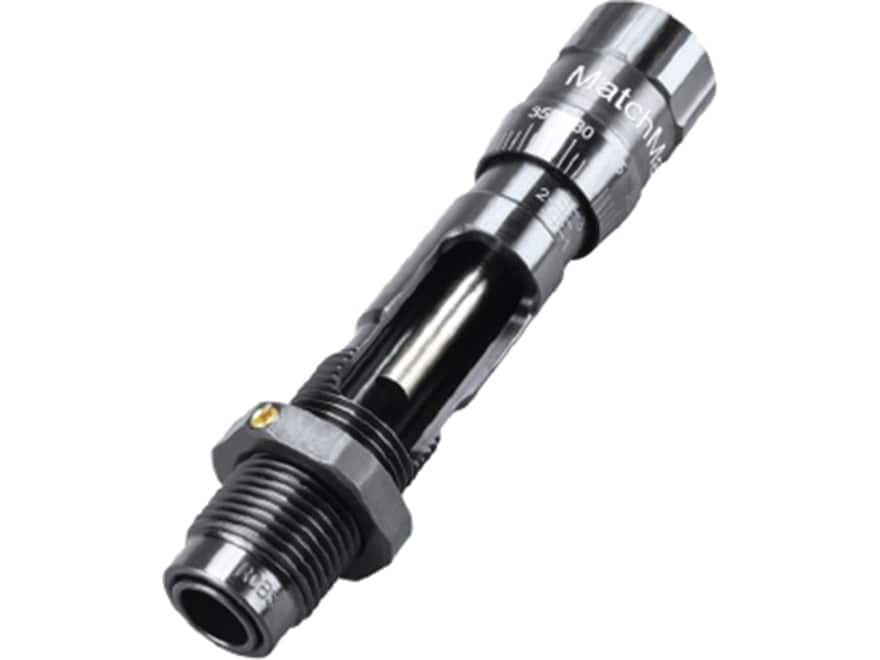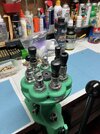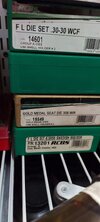Is there really a big difference between seating dies when it comes to Lee, RCBS, Redding? Cant find my RCBS seating die after moving so thinking about getting a step up and buying Redding. I have access to a Lee seater but I’m trying to squeeze out as much accuracy as possible.
You are using an out of date browser. It may not display this or other websites correctly.
You should upgrade or use an alternative browser.
You should upgrade or use an alternative browser.
Better grade dies
- Thread starter Axis II
- Start date
CQB45ACP
Member
No controversy here. Straightforward & near unanimity on THR, the best is…Is there really a big difference between seating dies when it comes to Lee, RCBS, Redding? Cant find my RCBS seating die after moving so thinking about getting a step up and buying Redding. I have access to a Lee seater but I’m trying to squeeze out as much accuracy as possible.
Standard seating dies from the manufacturers you mention can produce rounds with good concentricity. Other things like the sizing die also contribute to the concentricity of finished rounds. A standard seating die from Lee or Redding will probably give you results similar to that of your missing RCBS seater.
CQB45ACP
Member
LiveLife
Member
FWIW, my Lee 9mm seaters have produced down to .001" consistency in finished OAL on SPP/Pro 6000 and 2023 Breech Lock Head Pro 1000 and even myth busted/confirmed here - https://www.thehighroad.org/index.p...e-consistent-oal-on-progressive-press.921633/No controversy here. Straightforward & near unanimity on THR, the best is…
I have RCBS, Dillon and Hornady Custom Grade dies and could do a comparison test but hard to beat .001" OAL variance.
GeoDudeFlorida
Member
- Joined
- Dec 1, 2020
- Messages
- 11,067
Matching the stem shape to the bullet ogive is something to consider.Standard seating dies from the manufacturers you mention can produce rounds with good concentricity. Other things like the sizing die also contribute to the concentricity of finished rounds. A standard seating die from Lee or Redding will probably give you results similar to that of your missing RCBS seater.
Highland Lofts
Member
- Joined
- May 1, 2019
- Messages
- 3,035
I like the Hornady seater dies.
rfwobbly
Member
To me Seating variation comes from 2 sources....
• Lack of case lubrication. True, "carbide dies don't require lubrication", but no one ever said that carbide dies can't improve with case lubrication. Especially on multi-station presses where case Sizing is going on during the Seating process. If the Sizing doesn't go smoothly, then the bullet Seating also suffers.
• Improper Seating "anvil" shapes. When the part of the die pushing on the bullet's ogive doesn't fit, then the result is bullets that aren't centered or seated straight. So if your Seating Die doesn't have multiple choices so that you can swap the anvil out to achieve the best fit, then your OALs are naturally going to vary by a greater degree.
• Lack of case lubrication. True, "carbide dies don't require lubrication", but no one ever said that carbide dies can't improve with case lubrication. Especially on multi-station presses where case Sizing is going on during the Seating process. If the Sizing doesn't go smoothly, then the bullet Seating also suffers.
• Improper Seating "anvil" shapes. When the part of the die pushing on the bullet's ogive doesn't fit, then the result is bullets that aren't centered or seated straight. So if your Seating Die doesn't have multiple choices so that you can swap the anvil out to achieve the best fit, then your OALs are naturally going to vary by a greater degree.
NMexJim
Member
I think to answer the question, we need to clarify between rifles and handguns. Really, I don't know of any die maker that doesn't turn out a great product. We could full stop here. But ......
For handguns, I got rid of my RCBS dies and went Hornady (I know, I know - blaspheme), but I just like how the seater dies work. In fact, I sold all my RCBS on here - snapped right up.
In rifles, I think you have got to define what results you want, and you have to have an honest assessment of the accuracy level of your rifles. What's the saying "put lipstick on a pig"? Most rifles will do well with standard dies.
I happen to have both Hornady New Dimension and Redding Series A for general work in hunting rifles. Really not much difference between the two in my opinion. They both turn out very good ammo, especially w/ careful brass prep.
For my varmint rifles, I finally tried Redding Type S bushing dies. After some time working w/ them, I'm happy I came this way. A tad expensive in relation to standard dies. I admit that I haven't been tempted to try them for my hunters.
For handguns, I got rid of my RCBS dies and went Hornady (I know, I know - blaspheme), but I just like how the seater dies work. In fact, I sold all my RCBS on here - snapped right up.
In rifles, I think you have got to define what results you want, and you have to have an honest assessment of the accuracy level of your rifles. What's the saying "put lipstick on a pig"? Most rifles will do well with standard dies.
I happen to have both Hornady New Dimension and Redding Series A for general work in hunting rifles. Really not much difference between the two in my opinion. They both turn out very good ammo, especially w/ careful brass prep.
For my varmint rifles, I finally tried Redding Type S bushing dies. After some time working w/ them, I'm happy I came this way. A tad expensive in relation to standard dies. I admit that I haven't been tempted to try them for my hunters.
gwpercle
Member
There is a difference in the dies ... the more expensive have tighter tolerances and better fit and finish ...
I mean you do Get what you Pay for .
If you are looking to load the most accurate ammo you can ... get the Redding Competition Seating Die .
More than likely you will up grade after using the Redding Die for a short time ...
They are just so nice to use ... expensive but Nice !
Gary
I mean you do Get what you Pay for .
If you are looking to load the most accurate ammo you can ... get the Redding Competition Seating Die .
More than likely you will up grade after using the Redding Die for a short time ...
They are just so nice to use ... expensive but Nice !
Gary
CQB45ACP
Member
Exactly and then get the micrometer add-on for the other die.There is a difference in the dies ... the more expensive have tighter tolerances and better fit and finish ...
I mean you do Get what you Pay for .
If you are looking to load the most accurate ammo you can ... get the Redding Competition Seating Die .
More than likely you will up grade after using the Redding Die for a short time ...
They are just so nice to use ... expensive but Nice !
Gary
They’re the best in my book but are they necessary? Who knows.
It isn't that lessor dies can produce the same results, it's that better dies make it easier for the user to attain their desired results.Is there really a big difference between seating dies when it comes to Lee, RCBS, Redding? Cant find my RCBS seating die after moving so thinking about getting a step up and buying Redding. I have access to a Lee seater but I’m trying to squeeze out as much accuracy as possible.
I use Redding Competition Seating dies when loading 9mm, .38Spl, and .45ACP. The sliding sleeve and how the floating plunger contact the ogive of the bullet help with consistent alignment. The micrometer allows precise adjustment and easy returns to OAL when changing bullet shapes/weights
nettlle
Contributing Member
I have a Redding Competition Seating die. I also have Dillon and RCBS seating dies. The Redding Competition Seating die is a nicer die to work with. Well worth the extra cost.
troy fairweather
Member
There all pretty good, each has its quirks and advantages. Like Lee will work seating ackleys rcbs won't, other maybe better for your purpose. Rcbs cs has been so good so I buy mostly there stuff now, but for the 6mm arc dies I may go hornady.
tightgroup tiger
Member
I use the Redding Comp seating die also and do like it but I had trouble with mine at first.
It has a feature where you can set the zero to your most common seating depth you use, then you can record the + or - micrometer number for any other bullet you want to try. This will give you a record to go by if you decide to record the settings for each type of bullet you use.
I keep track to a certain extent.
But, my OALs started growing while I was loading and it turned out an adjustment screw inside it was unscrewing while I was using it, changing my OAL a little on every so many rounds. Some blue locktite fixed it. I was disappointed that I had to take it apart to do this after just paying $103.00 for it, but it's been really good ever since.
You also have to watch the setting on it while your loading , the mic only has an o-ring for friction and my mic would unscrew when loading a lot at one time.
After using it for several years I do think their 9mm Comp Seating die is worth the extra money because their seating stem seems to fit all the 9mm bullets I use, and they are all seated straight.
After that the Micrometer is just a bonus.
It has a feature where you can set the zero to your most common seating depth you use, then you can record the + or - micrometer number for any other bullet you want to try. This will give you a record to go by if you decide to record the settings for each type of bullet you use.
I keep track to a certain extent.
But, my OALs started growing while I was loading and it turned out an adjustment screw inside it was unscrewing while I was using it, changing my OAL a little on every so many rounds. Some blue locktite fixed it. I was disappointed that I had to take it apart to do this after just paying $103.00 for it, but it's been really good ever since.
You also have to watch the setting on it while your loading , the mic only has an o-ring for friction and my mic would unscrew when loading a lot at one time.
After using it for several years I do think their 9mm Comp Seating die is worth the extra money because their seating stem seems to fit all the 9mm bullets I use, and they are all seated straight.
After that the Micrometer is just a bonus.
nettlle
Contributing Member
With any seating die, rifle or pistol, I keep a set of calipers next to the press and check every 30-40 rounds. Not that I have had that many problems with seating dies but just a habit I have gotten in to. It's just easier than playing whack-o mole with a bullet puller. Like tightgroup says. You never know.
Last edited:
AJC1
Member
If you want to stay with rcbs the matchmaster seating dies are a definite upgrade. I have 308 and 223. I love dropping the bullet in the window and pulling the handle...
nettlle
Contributing Member
Took a look at the RCBS Matchmaster. Pretty neat setup!
tightgroup tiger
Member
I haven't tried those yet. They look pretty slick.
AJC1
Member
If your looking to pick one up they used to be called gold medal match and come in a gold box... same die.I haven't tried those yet. They look pretty slick.
Attachments
nettlle
Contributing Member
Midway has them

 www.midwayusa.com
www.midwayusa.com

RCBS MatchMaster Competition Seater Die 223 Remington
What sets the MatchMaster seating die apart from the competition is the bullet seating window with bullet retaining system. Simply place the bullet in...
MarshallDodge
Member
I agree with the others, die features and quality make them nicer to use, and worth the extra money.
Over the years I have tried a lot of different brands of dies. My favorite is Redding and Mighty Armory, but I don't think anybody makes bad dies. I've made some really accurate 223 ammo with Lee 223 dies, that I paid less than $20 for a set, but I like the Mighty Armory sizing die and Forster seating die better.
Over the years I have tried a lot of different brands of dies. My favorite is Redding and Mighty Armory, but I don't think anybody makes bad dies. I've made some really accurate 223 ammo with Lee 223 dies, that I paid less than $20 for a set, but I like the Mighty Armory sizing die and Forster seating die better.
Why wouldn't a seating die be able to provide .001" consistency? Is there flex or something in a die that would cause variance?FWIW, my Lee 9mm seaters have produced down to .001" consistency in finished OAL on SPP/Pro 6000 and 2023 Breech Lock Head Pro 1000 and even myth busted/confirmed here - https://www.thehighroad.org/index.p...e-consistent-oal-on-progressive-press.921633/
I have RCBS, Dillon and Hornady Custom Grade dies and could do a comparison test but hard to beat .001" OAL variance.
LiveLife
Member
Sure if you are loading on a single stage.Why wouldn't a seating die be able to provide .001" consistency? Is there flex or something in a die that would cause variance?my Lee 9mm seaters have produced down to .001" consistency in finished OAL on SPP/Pro 6000 and 2023 Breech Lock Head Pro 1000 and even myth busted/confirmed here - https://www.thehighroad.org/index.p...e-consistent-oal-on-progressive-press.921633/
But I was loading on progressive presses in full progressive mode with shellplates full using unsorted range brass by case length.
Dillon 550 differs from other progressive presses like 650/750 in that shellplate does not capture the base of case rather pushes/slides cases on top of the platform which does not move. So differing resizing force on shellplate does not affect force on bullet seating die to act like a single stage when bullet is seated, producing more consistent OAL. Starting with Lee ABLP and continued on SPP and 2023 Pro 1K; while shellplates capture case base, "free-floating" shellplate design is utilized so during resizing or any force applied to the shellplate, shellplate simply drops down flat on solid carrier similar to 550 platform, which I attribute to producing .001" OAL variance that is hard to do with progressive press running in progressive mode with full shellplate using unsorted range brass by case length.
That's one of the reasons I went with the Hornady LNL AP as my first press. That combined with the spent primer handling and easy change dies made the choice very easy.Dillon 550 differs from other progressive presses like 650/750 in that shellplate does not capture the base of case rather pushes/slides cases on top of the platform which does not move.
How interesting. As loose as the shell plate seemed, I wondered how they maintained such consistencyStarting with Lee ABLP and continued on SPP and 2023 Pro 1K; while shellplates capture case base, "free-floating" shellplate design is utilized so during resizing or any force applied to the shellplate, shellplate simply drops down flat on solid carrier similar to 550 platform
Similar threads
- Replies
- 9
- Views
- 336
- Replies
- 12
- Views
- 3K
- Replies
- 25
- Views
- 1K



